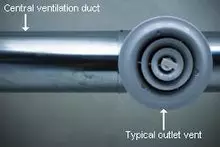 Image source: sanaulac.vn
Image source: sanaulac.vn
When it comes to maximizing comfort and maintaining a healthy indoor environment, heating, ventilation, and air conditioning (HVAC) systems play a crucial role. These systems utilize various technologies to control the temperature, humidity, and air purity in enclosed spaces. By providing thermal comfort and acceptable indoor air quality, HVAC systems create a pleasant atmosphere for both residential and commercial buildings.
Ensuring Comfort and Indoor Air Quality
The design of HVAC systems is based on the principles of thermodynamics, fluid mechanics, and heat transfer. Heating, cooling, and ventilation are interrelated functions in these systems, all aimed at achieving thermal comfort and maintaining indoor air quality. HVAC systems can be found in various settings, including residential structures, industrial and office buildings, vehicles, and marine environments.
Ventilation, a vital aspect of HVAC, involves the exchange of air to remove odors, moisture, and other contaminants while replenishing oxygen. Proper ventilation helps regulate temperature, remove airborne bacteria, and prevent the stagnation of indoor air. There are two main types of ventilation: mechanical (forced) and natural.
Integration and Efficiency
In modern buildings, HVAC functions are often integrated into centralized systems, where heating, cooling, and ventilation are controlled simultaneously. For small buildings, contractors estimate the required system capacity and components, while larger buildings rely on building service designers and mechanical engineers for analysis, design, and specification. Specialized contractors and suppliers then fabricate, install, and commission these systems, ensuring compliance with building codes.
Furthermore, HVAC can be extended beyond individual buildings through district heating or cooling networks. By using a larger network, HVAC systems can achieve an economy of scale and efficiently utilize renewable energy sources such as solar heat, winter's cold, and natural cooling sources. This approach is environmentally friendly and promotes the exploration of different methods to improve energy efficiency.
A Brief History
The development of HVAC systems can be attributed to numerous inventors and innovators. From Nikolay Lvov and Michael Faraday to Willis Carrier and Reuben Trane, these individuals have contributed to the advancement of this field. The first residential air conditioning unit was installed in 1914, marking the widespread adoption of residential AC.
The Importance of Heating
Heating systems, including boilers, furnaces, and heat pumps, generate warmth to ensure optimal indoor temperatures. These systems can transfer heat through convection, conduction, or radiation. Some heaters use solid fuels, liquids, or gases, while others rely on electricity. Heat pumps, which gained popularity in the 1950s, extract heat from various sources such as the environment or exhaust air to warm the indoor space. By using heat transfer mediums like water or air, heating systems contribute to the overall comfort of a building.
Ventilation and Air Distribution
Ventilation is responsible for exchanging and replacing air in a space. It controls temperature, replenishes oxygen, and removes moisture, odors, smoke, dust, and other contaminants. Ventilation methods can be mechanical or natural, depending on the needs and characteristics of the building.
In mechanical ventilation, fans and air handlers provide air circulation and filtration. These systems effectively control humidity, odors, and contaminants, often incorporating kitchen and bathroom exhausts. On the other hand, natural ventilation utilizes operable windows, louvers, or other architectural features to allow fresh air into the building while removing stale air. Natural ventilation is cost-effective and well-suited for specific climates and limited-resource settings.
Air Conditioning and Cooling
Air conditioning systems are essential for cooling and maintaining humidity control in a building. These systems utilize refrigeration technology to extract heat from the indoor air, resulting in a comfortable and cooler environment. Air conditioners can be standalone or part of a centralized system, and they often involve both indoor and outdoor units. The performance of air conditioning systems is measured by the Energy Efficiency Ratio (EER) or the Seasonal Energy Efficiency Ratio (SEER), which takes into account seasonal temperature averages.
Energy Efficiency and Environmental Considerations
Energy efficiency is a key focus for HVAC systems, as the building sector consumes a significant amount of global energy. Manufacturers have made substantial efforts to improve the efficiency of HVAC equipment, driven by rising energy costs and environmental concerns. Efficient HVAC systems promote energy conservation, occupant health, and productivity.
To enhance efficiency, various techniques and technologies have been developed. These include zoned heating, ground source heat pumps, solar air conditioning, and energy recovery systems that utilize heat exchangers to recover energy from exhausted air. By implementing these advancements, buildings can achieve greater energy savings and reduce their environmental impact.
The Role of HVAC Technicians
The installation, operation, and maintenance of HVAC systems require skilled professionals known as HVAC technicians. These technicians specialize in heating, ventilation, air conditioning, and refrigeration. They receive formal training and often complete apprenticeships to acquire the necessary knowledge and skills. HVAC technicians can also specialize in specific areas such as air conditioning, heat pumps, and commercial refrigeration.
Conclusion
The field of heating, ventilation, and air conditioning plays a crucial role in creating comfortable and healthy indoor environments. HVAC systems promote thermal comfort, maintain indoor air quality, and contribute to energy efficiency. From heating and cooling to ventilation and air distribution, these systems are vital components of residential and commercial buildings worldwide. With ongoing advancements and the expertise of HVAC technicians, the industry continues to evolve and improve, providing optimal comfort and environmental sustainability.

















